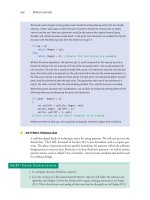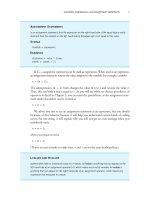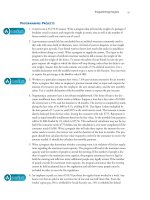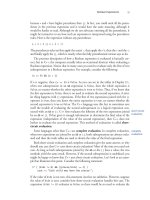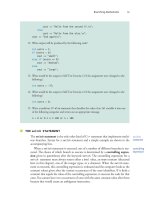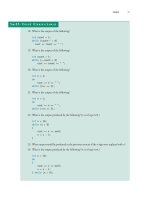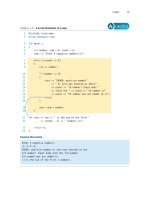Absolute C++ (4th Edition) part 23 doc
Bạn đang xem bản rút gọn của tài liệu. Xem và tải ngay bản đầy đủ của tài liệu tại đây (327.7 KB, 10 trang )
6
Structures and Classes
6.1 STRUCTURES 224
Structure Types 226
Pitfall: Forgetting a Semicolon in a Structure Definition 230
Structures as Function Arguments 230
Tip: Use Hierarchical Structures 231
Initializing Structures 234
6.2 CLASSES 236
Defining Classes and Member Functions 236
Encapsulation 242
Public and Private Members 243
Accessor and Mutator Functions 247
Tip: Separate Interface and Implementation 248
Tip: A Test for Encapsulation 249
Structures versus Classes 250
Tip: Thinking Objects 252
CHAPTER SUMMARY 252
ANSWERS TO SELF-TEST EXERCISES 253
PROGRAMMING PROJECTS 255
06_CH06.fm Page 223 Wednesday, August 13, 2003 12:54 PM
6
Structures and Classes
‘The time has come,’ the Walrus said,
‘To talk of many things:
Of shoes—and ships—and sealing wax—
Of cabbages—and kings.’
Lewis Carrol
l,
Through the Looking Glass
INTRODUCTION
Classes are perhaps the single most significant feature that separates the C++
language from the C language. A
class
is a type whose values are called
objects
.
Objects have both data and member functions. The member functions have
special access to the data of their object. These objects are the objects of
object-oriented programming, a very popular and powerful programming
philosophy.
We will introduce classes in two steps. We first tell you how to give a type
definition for a structure. A
structure
(of the kind discussed here) can be
thought of as an object without any member functions.
1
The important prop-
erty of structures is that the data in a structure can be a collection of data
items of diverse types. After you learn about structures it will be a natural
extension to define classes.
You do not need the material on arrays given in Chapter 5 in order to read
Chapter 6, and most of Chapters 7 and 8, which cover classes.
Structures
I don’t care to belong to any club that will accept me as a member.
Groucho Marx,
The Groucho Letters
Sometimes it is useful to have a collection of values of different types and to
treat the collection as a single item. For example, consider a bank certificate of
deposit, which is often called a CD. A CD is a bank account that does not
allow withdrawals for a specified number of months. A CD naturally has three
1
A structure actually can have member functions in C++, but that is not the approach
we will take. This detail is explained later in the chapter. This footnote is only to let
readers who feel they have found an error know that we are aware of the official defini-
tion of a structure. Most readers should ignore this footnote.
structure
6.1
06_CH06.fm Page 224 Wednesday, August 13, 2003 12:54 PM
Structures 225
pieces of data associated with it: the account balance, the interest rate for the account,
and the term, which is the number of months until maturity. The first two items can be
represented as values of type
double
, and the number of months can be represented as a
value of type
int
.
Display 6.1
shows the definition of a structure called
CDAccountV1
that can be used for this kind of account. (The V1 stands for version 1. We will define
an improved version later in this chapter.)
Display 6.1 A Structure Definition
(part 1 of 2)
1 //Program to demonstrate the CDAccountV1 structure type.
2 #include <iostream>
3 using namespace std;
4 //Structure for a bank certificate of deposit:
5 struct CDAccountV1
6 {
7 double balance;
8 double interestRate;
9 int term;//months until maturity
10 };
11 void getData(CDAccountV1& theAccount);
12 //Postcondition: theAccount.balance, theAccount.interestRate, and
13 //theAccount.term have been given values that the user entered at the keyboard.
14 int main(
)
15 {
16 CDAccountV1 account;
17 getData(account);
18 double rateFraction, interest;
19 rateFraction = account.interestRate/100.0;
20 interest = account.balance*(rateFraction*(account.term/12.0));
21 account.balance = account.balance + interest;
22 cout.setf(ios::fixed);
23 cout.setf(ios::showpoint);
24 cout.precision(2);
25 cout << "When your CD matures in "
26 << account.term << " months,\n"
27 << "it will have a balance of $"
28 << account.balance << endl;
29 return 0;
30 }
An improved version of this structure
will be given later in this chapter.
06_CH06.fm Page 225 Wednesday, August 13, 2003 12:54 PM
226 Structures and Classes
■
STRUCTURE TYPES
The structure definition in Display 6.1 is as follows:
struct CDAccountV1
{
double balance;
double interestRate;
int term;//months until maturity
};
The keyword
struct
announces that this is a structure type definition. The identifier
CDAccountV1
is the name of the structure type, which is known as the
structure tag
.
The structure tag can be any legal identifier that is not a keyword. Although this is not
required by the C++ language, structure tags are usually spelled starting with an upper-
case letter. The identifiers declared inside the braces,
{}
, are called
member names
. As
illustrated in this example, a structure type definition ends with both a brace,
}
, and a
semicolon.
A structure definition is usually placed outside any function definition (in the same
way that globally defined constant declarations are placed outside all function defini-
tions). The structure type is then a global definition that is available to all the code that
follows the structure definition.
Once a structure type definition has been given, the structure type can be used just
like the predefined types
int
,
char
, and so forth. Note that in Display 6.1 the structure
Display 6.1 A Structure Definition
(part 2 of 2)
31 //Uses iostream:
32 void getData(CDAccountV1& theAccount)
33 {
34 cout << "Enter account balance: $";
35 cin >> theAccount.balance;
36 cout << "Enter account interest rate: ";
37 cin >> theAccount.interestRate;
38 cout << "Enter the number of months until maturity: ";
39 cin >> theAccount.term;
40 }
S
AMPLE
D
IALOGUE
Enter account balance: $100.00
Enter account interest rate: 10.0
Enter the number of months until maturity: 6
When your CD matures in 6 months,
it will have a balance of $105.00
struct
structure tag
member name
where to place
a structure
definition
06_CH06.fm Page 226 Wednesday, August 13, 2003 12:54 PM
Structures 227
type
CDAccountV1
is used to declare a variable in the function
main
and is used as the
name of the parameter type for the function
getData
.
A structure variable can hold values just like any other variable can. A
structure
value
is a collection of smaller values called
member values
. There is one member
value for each member name declared in the structure definition. For example, a value
of the type
CDAccountV1
is a collection of three member values, two of type
double
and
one of type
int
. The member values that together make up the structure value are
stored in member variables, which we discuss next.
Each structure type specifies a list of member names. In Display 6.1 the structure
CDAccountV1
has three member names:
balance
,
interestRate
, and
term
. Each of
these member names can be used to pick out one smaller variable that is a part of the
larger structure variable. These smaller variables are called
member variables
. Member
variables are specified by giving the name of the structure variable followed by a dot
and then the member name. For example, if
account
is a structure variable of type
CDAccountV1
(as declared in Display 6.1), then the structure variable
account
has the
following three member variables:
account.balance
account.interestRate
account.term
The first two member variables are of type
double
, and the last is of type
int
. As illus-
trated in Display 6.1, these member variables can be used just like any other variables
of those types. For example, the following line from the program in Display 6.1 will
add the value contained in the member variable
account.balance
and the value con-
tained in the ordinary variable
interest
and will then place the result in the member
variable
account.balance
:
account.balance = account.balance + interest;
Two or more structure types may use the same member names. For example, it is
perfectly legal to have the following two type definitions in the same program:
struct FertilizerStock
{
double quantity;
double nitrogenContent;
};
and
struct CropYield
{
int quantity;
double size;
};
structure
value
member
value
member
variable
reusing
member
names
06_CH06.fm Page 227 Wednesday, August 13, 2003 12:54 PM
228 Structures and Classes
This coincidence of names will produce no problems. For example, if you declare the
following two structure variables:
FertilizerStock superGrow;
CropYield apples;
then the quantity of
superGrow
fertilizer is stored in the member variable
super-
Grow.quantity
and the quantity of apples produced is stored in the member variable
apples.quantity
. The dot operator and the structure variable specify which
quantity
is meant in each instance.
A structure value can be viewed as a collection of member values. A structure value
can also be viewed as a single (complex) value (that just happens to be made up of
member values). Since a structure value can be viewed as a single value, structure values
and structure variables can be used in the same ways that you use simple values and
simple variables of the predefined types such as
int
. In particular, you can assign struc-
ture values using the equal sign. For example, if
apples
and
oranges
are structure vari-
ables of the type
CropYield
defined earlier, then the following is perfectly legal:
apples = oranges;
T
HE
D
OT
O
PERATOR
The dd
dd
oo
oo
tt
tt
oo
oo
pp
pp
ee
ee
rr
rr
aa
aa
tt
tt
oo
oo
rr
rr
is used to specify a member variable of a structure variable.
Syntax
Structure_Variable_Name
.
Member_Variable_Name
E
XAMPLES
struct StudentRecord
{
int studentNumber;
char grade;
};
int main( )
{
StudentRecord yourRecord;
yourRecord.studentNumber = 2001;
yourRecord.grade = ’A’;
Some writers call the dot operator the
structure member access operator
, although we will not use
that term.
Dot operator
structure
variables in
assignment
statements
06_CH06.fm Page 228 Wednesday, August 13, 2003 12:54 PM
Structures 229
The previous assignment statement is equivalent to
apples.quantity = oranges.quantity;
apples.size = oranges.size;
S
IMPLE
S
TRUCTURE
T
YPES
You define a structure type as shown below. The
Structure_Tag
is the name of the structure type.
S
YNTAX
struct
Structure_Tag
{
Type_1
Member_Variable_Name_1
;
Type_2
Member_Variable_Name_2
;
.
.
.
Type_Last
Member_Variable_Name_Last
;
};
E
XAMPLE
struct Automobile
{
int year;
int doors;
double horsePower;
char model;
};
Although we will not use this feature, you can combine member names of the same type into a
single list separated by commas. For example, the following is equivalent to the above structure
definition:
struct Automobile
{
int year, doors;
double horsePower;
char model;
};
Variables of a structure type can be declared in the same way as variables of other types. For
example:
Automobile myCar, yourCar;
The member variables are specified using the dot operator. For example: myCar.year,
myCar.doors, myCar.horsePower, and myCar.model.
Do not forget this semicolon.
06_CH06.fm Page 229 Wednesday, August 13, 2003 12:54 PM
230 Structures and Classes
Pitfall
F
ORGETTING
A
S
EMICOLON
IN
A
S
TRUCTURE
D
EFINITION
When you add the final brace, }, to a structure definition, it feels like the structure definition is
finished, but it is not. You must also place a semicolon after that final brace. There is a reason for
this, even though the reason is a feature that we will have no occasion to use. A structure defini-
tion is more than a definition. It can also be used to declare structure variables. You are allowed
to list structure variable names between that final brace and that final semicolon. For example,
the following defines a structure called
WeatherData and declares two structure variables,
dataPoint1 and dataPoint2, both of type WeatherData:
struct WeatherData
{
double temperature;
double windVelocity;
} dataPoint1, dataPoint2;
■
STRUCTURES AS FUNCTION ARGUMENTS
A function can have call-by-value parameters of a structure type or call-by-reference
parameters of a structure type, or both. The program in Display 6.1, for example,
includes a function named
getData that has a call-by-reference parameter with the
structure type
CDAccountV1.
A structure type can also be the type for the value returned by a function. For exam-
ple, the following defines a function that takes one argument of type
CDAccountV1 and
returns a different structure of type
CDAccountV1. The structure returned will have the
same balance and term as the argument, but will pay double the interest rate that the
argument pays.
CDAccountV1 doubleInterest(CDAccountV1 oldAccount)
{
CDAccountV1 temp;
temp = oldAccount;
temp.interestRate = 2*oldAccount.interestRate;
return temp;
}
Notice the local variable temp of type CDAccountV1; temp is used to build up a complete
structure value of the desired kind, which is then returned by the function. If
myAccount
is a variable of type CDAccountV1 that has been given values for its member variables,
then the following will give
yourAccount values for an account with double the interest
rate of
myAccount:
CDAccountV1 yourAccount;
yourAccount = doubleInterest(myAccount);
structure
arguments
functions
can return
structures
06_CH06.fm Page 230 Wednesday, August 13, 2003 12:54 PM
Structures 231
Tip
U
SE
H
IERARCHICAL
S
TRUCTURES
Sometimes it makes sense to have structures whose members are themselves smaller structures.
For example, a structure type called
PersonInfo that can be used to store a person’s height,
weight, and birth date can be defined as follows:
struct Date
{
int month;
int day;
int year;
};
struct PersonInfo
{
double height;//in inches
int weight;//in pounds
Date birthday;
};
A structure variable of type PersonInfo is declared in the usual way:
PersonInfo person1;
If the structure variable person1 has had its value set to record a person’s birth date, then the
year the person was born can be output to the screen as follows:
cout << person1.birthday.year;
The way to read such expressions is left to right, and very carefully. Starting at the left end,
person1 is a structure variable of type PersonInfo. To obtain the member variable with the
name
birthday, you use the dot operator as follows:
person1.birthday
This member variable is itself a structure variable of type Date. Thus, this member variable itself
has member variables. A member variable of the structure variable
person1.birthday is
obtained by adding a dot and the member variable name, such as
year, which produces the
expression
person1.birthday.year shown above.
In Display 6.2 we have rewritten the class for a certificate of deposit from Display 6.1. This new ver-
sion has a member variable of the structure type Date that holds the date of maturity. We have
also replaced the single
balance member variable with two new member variables giving the
initial balance and the balance at maturity.
06_CH06.fm Page 231 Wednesday, August 13, 2003 12:54 PM
232 Structures and Classes
Display 6.2 A Structure with a Structure Member
(part 1 of 2)
1 //Program to demonstrate the CDAccount structure type.
2 #include <iostream>
3 using namespace std;
4 struct Date
5 {
6 int month;
7 int day;
8 int year;
9 };
10 //Improved structure for a bank certificate of deposit:
11 struct CDAccount
12 {
13 double initialBalance;
14 double interestRate;
15 int term;//months until maturity
16 Date maturity; //date when CD matures
17 double balanceAtMaturity;
18 };
19 void getCDData(CDAccount& theAccount);
20 //Postcondition: theAccount.initialBalance, theAccount.interestRate,
21 //theAccount.term, and theAccount.maturity have been given values
22 //that the user entered at the keyboard.
23
24 void getDate(Date& theDate);
25 //Postcondition: theDate.month, theDate.day, and theDate.year
26 //have been given values that the user entered at the keyboard.
27 int main(
)
28 {
29 CDAccount account;
30 cout << "Enter account data on the day account was opened:\n";
31 getCDData(account);
32 double rateFraction, interest;
33 rateFraction = account.interestRate/100.0;
34 interest = account.initialBalance*(rateFraction*(account.term/12.0));
35 account.balanceAtMaturity = account.initialBalance + interest;
36 cout.setf(ios::fixed);
37 cout.setf(ios::showpoint);
38 cout.precision(2);
39 cout << "When the CD matured on "
40 << account.maturity.month << "-" << account.maturity.day
This is an improved version of the structure
CDAccountV1 defined in Display 6.1.
06_CH06.fm Page 232 Wednesday, August 13, 2003 12:54 PM
